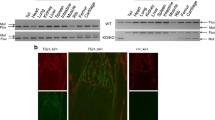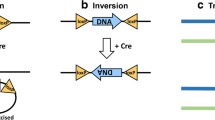Abstract
We have recently generated a transgenic mouse line (termed hRen-Cre) that expresses Cre-recombinase under the control of a 12.2-kb fragment of the human renin promoter. In the present study, we have crossed hRen-Cre mice with a mouse strain in which exon 1 of the Gnas gene is flanked by loxP sites. Gnas encodes the α-subunit of the stimulatory G protein (Gsα). Our aim has been to generate a mouse model with locally restricted inactivation of Gsα to extend studies of the role of Gsα function in vivo. Mice with local Cre-mediated inactivation of Gsα (rCre-Gsα) are viable and fertile. Their most obvious phenotype consists of marked skeletal malformations of the forelimbs in which computer-tomography scans reveal shortened and fused extremity bones. Extraskeletal ossifications occur in the subcutis and in skeletal muscles associated with the affected long bones. Plasma calcium, phosphate and parathyroid hormone are normal. Skin histology has demonstrated diffuse mineralization and ossification associated with the basal cells of hair follicles. This phenotype in part resembles syndromes in humans associated with loss-of-function of Gsα, such as Albright hereditary osteodystrophy and progressive osseous heteroplasia. The renal phenotype of rCre-Gsα mice is inconspicuous. Plasma renin concentration, ambient urine osmolarity, and the glomerular filtration rate of rCre-Gsα mice do not differ from controls. The absence of measurable functional changes in the renin-angiotensin system indicates insufficient Cre expression in juxtaglomerular granular cells in this strain of mice. Nevertheless, the present report reaffirms the importance of Gsα signaling for bone development and the suppression of ectopic ossification.










Similar content being viewed by others
References
Albright F, Burnett CH, Smith PH (1942) Pseodohypoparathyroidism: an example of “Seabright-Bantam syndrome”. Endocrinology 30:922–932
Baubonis W, Sauer B (1993) Genomic targeting with purified Cre recombinase. Nucleic Acids Res 21:2025–2029
Castrop H, Huang Y, Hashimoto S, Mizel D, Hansen P, Theilig F, Bachmann S, Deng C, Briggs J, Schnermann J (2004) Impairment of tubuloglomerular feedback regulation of GFR in ecto-5′-nucleotidase/CD73-deficient mice. J Clin Invest 114:634–642
Castrop H, Oppermann M, Weiss Y, Huang Y, Mizel D, Lu H, Germain S, Schweda F, Theilig F, Bachmann S, Briggs J, Kurtz A, Schnermann J (2006) Reporter gene recombination in juxtaglomerular granular and collecting duct cells by human renin promoter-Cre recombinase transgene. Physiol Genomics 25:277–285
Chen M, Gavrilova O, Liu J, Xie T, Deng C, Nguyen AT, Nackers LM, Lorenzo J, Shen L, Weinstein LS (2005) Alternative Gnas gene products have opposite effects on glucose and lipid metabolism. Proc Natl Acad Sci USA 102:7386–7391
Chen L, Kim SM, Oppermann M, Faulhaber-Walter R, Huang YG, Mizel D, Chen M, Sequeira Lopez ML, Weinstein LS, Gomez RA, Briggs JP, Schnermann JB (2006) Regulation of renin in mice with cre recombinase-mediated deletion of G protein Gs{alpha} in juxtaglomerular cells. Am J Physiol Renal Physiol 292:415–422
Corvol P, Schutz S, Gasc JM (1998) Early expression of all components of the renin-angiotensin system in human development. Adv Nephrol Necker Hosp 28:195–212
Eddy MC, Jan De Beur SM, Yandow SM, McAlister WH, Shore EM, Kaplan FS, Whyte MP, Levine MA (2000) Deficiency of the alpha-subunit of the stimulatory G protein and severe extraskeletal ossification. J Bone Miner Res 15:2074–2083
Ekker M, Tronik D, Rougeon F (1989) Extra-renal transcription of the renin genes in multiple tissues of mice and rats. Proc Natl Acad Sci USA 86:5155–5158
Everds N (2004) Hematology of the mouse. In: Bullock G, Petrusz P (eds) The handbook of experimental animals. Elsevier, London, pp 271–286
Fuchs S, Germain S, Philippe J, Corvol P, Pinet F (2002) Expression of renin in large arteries outside the kidney revealed by human renin promoter/LacZ transgenic mouse. Am J Pathol 161:717–725
Fukamizu A, Seo MS, Hatae T, Yokoyama M, Nomura T, Katsuki M, Murakami K (1989) Tissue-specific expression of the human renin gene in transgenic mice. Biochem Biophys Res Commun 165:826–832
Germain-Lee EL, Groman J, Crane JL, Jan de Beur SM, Levine MA (2003) Growth hormone deficiency in pseudohypoparathyroidism type 1a: another manifestation of multihormone resistance. J Clin Endocrinol Metab 88:4059–4069
Germain-Lee EL, Schwindinger W, Crane JL, Zewdu R, Zweifel LS, Wand G, Huso DL, Saji M, Ringel MD, Levine MA (2005) A mouse model of Albright hereditary osteodystrophy generated by targeted disruption of exon 1 of the Gnas gene. Endocrinology 146:4697–4709
Hackenthal E, Taugner R (1986) Hormonal signals and intracellular messengers for renin secretion. Mol Cell Endocrinol 47:1–12
Jones CA, Sigmund CD, McGowan RA, Kane-Haas CM, Gross KW (1990) Expression of murine renin genes during fetal development. Mol Endocrinol 4:375–383
Kaplan FS, Shore EM (2000) Progressive osseous heteroplasia. J Bone Miner Res 15:2084–2094
Keeton TK, Campbell WB (1980) The pharmacologic alteration of renin release. Pharmacol Rev 32:81–227
Li X, Okada Y, Pilbeam CC, Lorenzo JA, Kennedy CR, Breyer RM, Raisz LG (2000) Knockout of the murine prostaglandin EP2 receptor impairs osteoclastogenesis in vitro. Endocrinology 141:2054–2061
Mantovani G, Maghnie M, Weber G, De Menis E, Brunelli V, Cappa M, Loli P, Beck-Peccoz P, Spada A (2003) Growth hormone-releasing hormone resistance in pseudohypoparathyroidism type ia: new evidence for imprinting of the Gs alpha gene. J Clin Endocrinol Metab 88:4070–4074
Oppermann M, Mizel D, Huang G, Li C, Deng C, Theilig F, Bachmann S, Briggs J, Schnermann J, Castrop H (2006) Macula densa control of renin secretion and preglomerular resistance in mice with selective deletion of the B isoform of the Na,K,2Cl co-transporter. J Am Soc Nephrol 17:2143–2152
Phillips MI, Kimura B, Gyurko R (1994) Angiotensin receptor stimulation of transforming growth factor-β in rat skin and wound healing. Plenum, New York
Prendiville JS, Lucky AW, Mallory SB, Mughal Z, Mimouni F, Langman CB (1992) Osteoma cutis as a presenting sign of pseudohypoparathyroidism. Pediatr Dermatol 9:11–18
Qi Z, Whitt I, Mehta A, Jin J, Zhao M, Harris RC, Fogo AB, Breyer MD (2004) Serial determination of glomerular filtration rate in conscious mice using FITC-inulin clearance. Am J Physiol Renal Physiol 286:F590–F596
Sakamoto A, Chen M, Kobayashi T, Kronenberg HM, Weinstein LS (2005a) Chondrocyte-specific knockout of the G protein G(s)alpha leads to epiphyseal and growth plate abnormalities and ectopic chondrocyte formation. J Bone Miner Res 20:663–671
Sakamoto A, Chen M, Nakamura T, Xie T, Karsenty G, Weinstein LS (2005b) Deficiency of the G-protein alpha-subunit G(s)alpha in osteoblasts leads to differential effects on trabecular and cortical bone. J Biol Chem 280:21369–21375
Schutz S, Le Moullec JM, Corvol P, Gasc JM (1996) Early expression of all the components of the renin-angiotensin-system in human development. Am J Pathol 149:2067–2079
Sequeira Lopez ML, Pentz ES, Nomasa T, Smithies O, Gomez RA (2004) Renin cells are precursors for multiple cell types that switch to the renin phenotype when homeostasis is threatened. Dev Cell 6:719–728
Shore EM, Ahn J, Jan de Beur S, Li M, Xu M, Gardner RJ, Zasloff MA, Whyte MP, Levine MA, Kaplan FS (2002) Paternally inherited inactivating mutations of the GNAS1 gene in progressive osseous heteroplasia. N Engl J Med 346:99–106
Sigmund CD, Gross KW (1990) Differential expression of the murine and rat renin genes in peripheral subcutaneous tissue. Biochem Biophys Res Commun 173:218–223
Sigmund CD, Jones CA, Mullins JJ, Kim U, Gross KW (1990) Expression of murine renin genes in subcutaneous connective tissue. Proc Natl Acad Sci USA 87:7993–7997
Sood PP, Panigel M, Wegmann R (1987) The existence of renin-angiotensinogen system in the rat fetal brain. I. Immunocytochemical localization of renin-like activity at the 19th day of gestation. Cell Mol Biol 33:675–680
Steckelings UM, Wollschlager T, Peters J, Henz BM, Hermes B, Artuc M (2004) Human skin: source of and target organ for angiotensin II. Exp Dermatol 13:148–154
Steinbach HL, Young DA (1966) The Roentgen appearance of pseudohypoparathyroidism (PH) and pseudo-pseudohypoparathyroidism (PPH). Differentiation from other syndromes associated with short metacarpals, metatarsals, and phalanges. Am J Roentgenol Radium Ther Nucl Med 97:49–66
Weinstein LS, Yu S, Warner DR, Liu J (2001) Endocrine manifestations of stimulatory G protein alpha-subunit mutations and the role of genomic imprinting. Endocr Rev 22:675–705
Weinstein LS, Chen M, Xie T, Liu J (2006) Genetic diseases associated with heterotrimeric G proteins. Trends Pharmacol Sci 27:260–266
Wilson LC, Hall CM (2002) Albright’s hereditary osteodystrophy and pseudohypoparathyroidism. Semin Musculoskelet Radiol 6:273–283
Yamamoto T, Ozono K, Kasayama S, Yoh K, Hiroshima K, Takagi M, Matsumoto S, Michigami T, Yamaoka K, Kishimoto T, Okada S (1996) Increased IL-6-production by cells isolated from the fibrous bone dysplasia tissues in patients with McCune-Albright syndrome. J Clin Invest 98:30–35
Yu S, Yu D, Lee E, Eckhaus M, Lee R, Corria Z, Accili D, Westphal H, Weinstein LS (1998) Variable and tissue-specific hormone resistance in heterotrimeric Gs protein alpha-subunit (Gsalpha) knockout mice is due to tissue-specific imprinting of the Gsalpha gene. Proc Natl Acad Sci USA 95:8715–8720
Author information
Authors and Affiliations
Corresponding author
Additional information
This work was supported by intramural funds from the National Institute of Diabetes and Digestive and Kidney Diseases. H. Castrop was supported by a grant from the Deutsche Forschungsgemeinschaft (CA278/4-1).
Rights and permissions
About this article
Cite this article
Castrop, H., Oppermann, M., Mizel, D. et al. Skeletal abnormalities and extra-skeletal ossification in mice with restricted Gsα deletion caused by a renin promoter-Cre transgene. Cell Tissue Res 330, 487–501 (2007). https://doi.org/10.1007/s00441-007-0491-6
Received:
Accepted:
Published:
Issue Date:
DOI: https://doi.org/10.1007/s00441-007-0491-6




